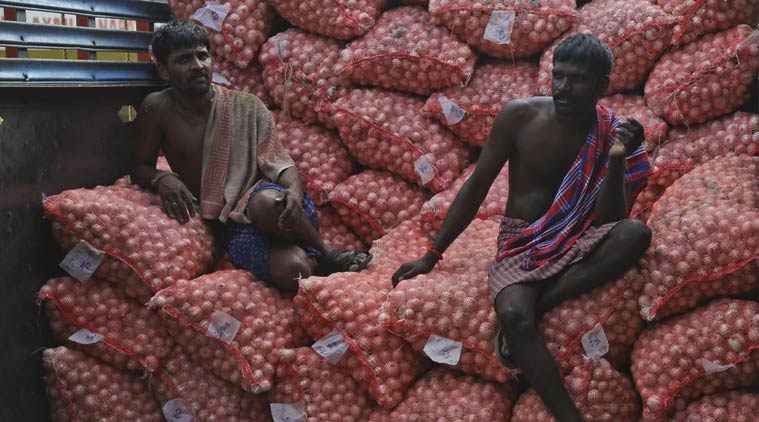September rains dry up tears on the onion front
The Centre’s response to it has been to increase the minimum export price (MEP) of onions from $250 to $700 per tonne, making it practically impossible to ship out any consignments from the country.
 Onions are harvested thrice annually in Maharashtra from October till April.
Onions are harvested thrice annually in Maharashtra from October till April.
Heavy rains in India’s main onion-growing belt over the past fortnight could provide some relief to both urban consumers as well as farmers of the bulb.
Nashik district, which produces roughly 15 per cent of the country’s onions, had recorded a 62 per cent rainfall deficit during the first three months of the south-west monsoon season, while also pushing back sowings by a month to 45 days. But over the past fortnight, the district has received almost 20 per cent more rains than what it normally receives during the whole of September
“Harvesting of the early-kharif crop will suffer over a month’s delay due to the shortfall in rains during June-August. The present showers are beneficial mainly to the late-kharif onions. Both these crops will now hit the market at the same time, thereby stabilising onion prices for consumers by the year-end,” said Nanasaheb Patil, chairman of the Agriculture Produce Market Committee at Lasalgaon, India’s biggest onion mandi.
[related-post]
Onions are harvested thrice annually in Maharashtra from October till April. The early-kharif crop, also known as “Pol” locally, is of inferior quality, has relatively low yields and cannot be stored for long. Planted in May-June and harvested in October-November, it accounts for a fifth of the state’s total onion crop. The sowing of it was affected this time due to delayed rains.
Moreover, even the September rains haven’t really benefited this crop. “Last week’s heavy downpour has affected some of the early-kharif plantations. I am worried about the quality of produce that will come out,” observed Bhausaheb Sawant, a farmer from Nampur in Satana Taluka of Nashik.
Others, too, paint a similar mixed picture.
“The average rainfall during a good monsoon here is around 17 inches till this time, whereas it has already touched 22 inches. However, until a fortnight ago, we had got only 4 inches, which means all this additional rain has been dumped in the last two seeks. This kind of rain is good to fill up our reservoirs, but damaging to the early-kharif crop,” noted Balasaheb Sonawane, a grower from Lasalgaon.
Farmers, nevertheless, point out that the rains will have a positive impact on the late-kharif crop, which is called “Rangda”. Planted in August-September and harvested towards January-February, it is better in quality and accounting for another 20 per cent of Maharashtra’s annual onion output. The late-kharif has, in fact, benefitted from the rains and its arrivals in the market by mid-January will help cool the current high onion prices.
“From a consumer standpoint, you could see a glut of onions, with both the early and late-kharif crop coming to the market almost at the same time,” Madhavrao Ghule, a farmer from Dindori said.
But the third and most important onion crop is the “Gavthi”. This is basically the rabi crop sown in December-January and marketed from April onwards. It is high yielding and of the best quality, also amenable to storage for up to six months. Making up 60 per cent of Maharashtra’s total onion production, it is the crop that suffered significant damage this time from unseasonal rains and hailstorm in March. The failure of “Gavthi” – which farmers normally store and release in staggered tranches before the early-kharif crop – has been the primary cause of the current spike in onion prices.
The Centre’s response to it has been to increase the minimum export price (MEP) of onions from $250 to $700 per tonne, making it practically impossible to ship out any consignments from the country.
“By imposing and hiking MEP, you are blocking the only opportunity we have to make some money. The government accuses us of hoarding, but indulges in activities itself to control the market. The answer to higher prices is increased production, but such shortsighted decisions will only dissuade us from undertaking onion cultivation,” complained Changdev Sonawane, a farmer from Pimpalgaon.
The main concern for onion farmers now is that in the event of prices falling – quite likely with the simultaneous arrival of both the early and late-kharif crops – there will be nobody to think about them, even as the government will take its own time in relaxing MEP restrictions.
Once prices cool, onions will also disappear from newspapers and TV channels, as is the case with potatoes today.
Maharashtra accounts for roughly 30 per cent of India’s annual onion crop of 185-190 lakh tonnes. Besides Nashik, Pune and Ahmednagar are the state’s other main onion-producing districts.





- 01
- 02
- 03
- 04
- 05


























